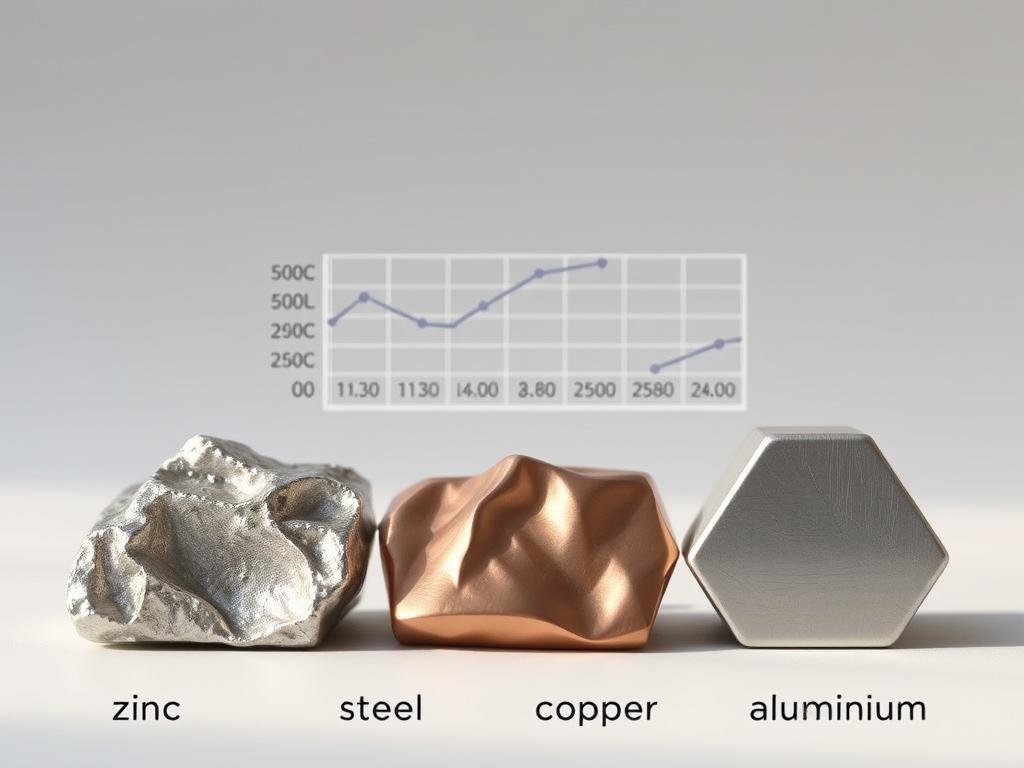Zinc is a versatile Metall with a Dichte of approximately 7.14 g/cm³ at room temperature, making it a relatively heavy metal compared to others like aluminum, but lighter than metals such as lead.
This comprehensive guide will explore the fundamental Eigenschaften von Zink, einschließlich seiner Atomstruktur und Position im Periodensystem, um den Kontext für das Verständnis seiner Dichte characteristics and various industrial Anwendungen in materials manufacturing.
Understanding zinc’s Eigenschaften ist entscheidend für seine effektive Nutzung in verschiedenen Branchen, von Bauwesen bis Fertigung, wo sein Dichte spielt eine entscheidende Rolle bei der Materialauswahl und Leistung.
The Fundamental Properties of Zinc
Zinc, a transition metal with atomic number 30, exhibits unique properties that make it invaluable in various industrial applications. Understanding zinc’s fundamental properties is crucial for appreciating its role in different industries.
Physical Characteristics and Atomic Structure
Zinc has an electronic configuration of [Ar]3d104s2, with two outer shell electrons that reduce its reactivity. This configuration contributes to its stability and characteristic metallic bonding, which influences its density, malleability, and ductility. The element naturally occurs in five stable isotopes, with zinc-64 being the most abundant, accounting for approximately 49% of naturally occurring zinc.
Zinc’s Position in the Periodic Table
Zinc occupies a strategic position in the periodic table as a transition metal in group 12, alongside cadmium and mercury. Its position helps explain its chemical properties and characteristic metallic bonding. The filled d-orbital in zinc’s electronic structure provides stability, making it less reactive compared to other metals.
Understanding the Density of Zinc
The density of zinc is a critical property that influences its applications across various industries. Density, a fundamental physical property, is defined as mass per unit volume. It is a crucial factor in determining the suitability of materials for different applications.
Was ist Dichte und wie wird sie gemessen?
Density is measured by dividing the mass of a substance by its volume. The formula for density is ρ = m/V, where ρ is density, m is mass, and V is volume. In the context of zinc, understanding its density is vital for calculating material requirements in manufacturing processes.
Zinc’s Density Value: 7.14 g/cm³
Bei Raumtemperatur hat Zink eine Dichte von 7,14 g/cm³ oder 7.140 kg/m³. Diese Dichte ergibt sich aus der hexagonalen dicht gepackten (HCP) Kristallstruktur von Zink, die eine Packungsdichte von etwa 74,1 % aufweist. Die HCP-Struktur ermöglicht es Zinkatomen, eng beieinander zu liegen, was es zu einem relativ dichten Metall macht. Einige wichtige Punkte zur Dichte von Zink sind:
- Zinc’s density of 7.14 g/cm³ places it in the medium-density range among metals, making it suitable for applications requiring moderate weight.
- The density value is significantly higher than that of lightweight metals like aluminum but lower than heavy metals like lead.
- Understanding zinc’s density is essential for predicting the weight of zinc-based components and calculating material requirements.
Factors Affecting Zinc Density
Several key factors can affect the density of zinc, making it crucial to understand their impact on this versatile metal. The density of zinc is not constant and can be influenced by various external and internal factors.
Temperature Dependence
The density of zinc varies with temperature due to its thermal expansion properties. As temperature increases, zinc expands, and its density decreases. This relationship is critical in applications where zinc is exposed to varying temperatures.
Pressure Effects and Impurities
Pressure has a direct impact on zinc’s density; higher pressure compresses the atoms closer together, increasing the density. This is represented by the formula ρ(P)=ρ0 ×(1+κ(P−P0)), where ρ0 is initial density, κ is compressibility, and P is pressure. The presence of impurities also significantly affects zinc’s density. Elements like lead, iron, and cadmium can alter the density; heavier impurities increase it, while lighter ones decrease it.
- The type and concentration of impurities can cause variations in zinc’s density, impacting its performance in precision applications.
- Qualitätskontrolle prozesse are essential to monitor and control impurity levels, ensuring consistent density specifications.
Comparing Zinc Density to Other Metals
Understanding how zinc density compares to other metals is crucial for selecting the right material for various industrial applications. Zinc’s density of 7.14 g/cm³ positions it as a medium-density metal.
Zinc vs. Lightweight Metals
Compared to lightweight metals like aluminum (2.7 g/cm³) and magnesium (1.8 g/cm³), zinc is denser. This difference in density makes zinc more suitable for applications requiring higher strength and durability. For instance, zinc alloys are often used in die casting for producing parts that need to withstand significant stress.

Zinc vs. Heavy Metals
Zinc is less dense than heavy metals such as iron (7.87 g/cm³), copper (8.96 g/cm³), and lead (11.34 g/cm³). This characteristic gives zinc an advantage in applications where weight is a concern, but strength and corrosion resistance are still necessary. For example, zinc is used as a coating for steel (galvanization) to provide corrosion protection without significantly adding weight. Additionally, zinc’s density being about 20% less than copper makes it a more economical choice for certain applications where copper’s superior electrical conductivity is not required.
Zinc Alloys and Their Density Properties
Alloying zinc with other elements can significantly alter its density, making it suitable for a wide range of applications. This modification in density is primarily due to the inherent density of the alloying elements and their effect on the crystal structure of zinc.
Common Zinc Alloys: Zamak and ZA Series
Zamak and ZA series are notable zinc alloys that exhibit distinct density properties. For instance, Zamak 3, which contains 96% zinc and 4% aluminum, has a density of 6.6 g/cm³. The addition of aluminum reduces the overall density, making it a lighter option compared to pure zinc.
Wie Legierungselemente die Dichte beeinflussen
The density of zinc alloys is influenced by the alloying elements through two primary mechanisms: substitutional alloying and interstitial alloying. Elements like aluminum (density: 2.7 g/cm³) decrease the overall density, while copper (density: 8.96 g/cm³) increases it. The relationship between alloy composition and density is generally linear, following the rule of mixtures.
- Alloying elements significantly influence zinc’s density through their inherent density and effect on the crystal structure.
- The precise control of alloy composition allows manufacturers to engineer materials with specific density properties.
Measuring and Calculating Zinc Density
Genaues Messen der Zinkdichte ist entscheidend für verschiedene industrielle Anwendungen. Die Dichte von Zink beeinflusst seine Leistung in unterschiedlichen Prozessen, einschließlich Gießen und Beschichtungen.
Laboratory Techniques for Density Measurement
In laboratory settings, density measurement techniques are employed to ensure precision. Methods include using density cups and pycnometers to measure the mass and volume of zinc samples accurately.
Practical Methods for Industrial Applications
In industriellen Umgebungen werden praktische Methoden eingesetzt, um die Zinkdichte effizient zu messen. Einige gängige Techniken umfassen:
- Verwendung automatisierter Systeme, die in Produktionslinien integriert sind, für die Echtzeit-Qualitätskontrolle.
- Verwendung von Dichtheitsbechern, um die Masse von geschmolzenem Zink mit einem Standard während des Gießvorgangs zu vergleichen.
- Verwendung von Ultraschalldichtemessgeräten für zerstörungsfreie Prüfungen fertiger Zinkkomponenten.
Prozesskontrolle ist entscheidend, um die gewünschte Dichte der Zinkteile aufrechtzuerhalten. Faktoren wie Temperatur, Druck und Verunreinigungen müssen überwacht und kontrolliert werden. Schwankungen in der Dichte können die Leistung von Zink bei Anwendungen wie Gießen beeinträchtigen.
| Methode | Beschreibung | Anwendung |
|---|---|---|
| Dichtebecher | Vergleiche die Masse von geschmolzenem Zink mit einem Standard | Casting-Operationen |
| Ultraschall-Dichtemessgeräte | Verwenden Sie die Ausbreitung von Schallwellen, um die Dichte zu bestimmen | Fertige Zinkkomponenten |
| Automatisierte Systeme | In die Produktionslinien für die Echtzeit-Qualitätskontrolle integriert | Industrielle Produktion |

Industrielle Anwendungen von Zink basierend auf der Dichte
Die moderate Dichte von Zink macht es zu einem idealen Material für zahlreiche industrielle Anwendungen. Seine ausgewogene Dichte bietet einen starken, langlebigen Schutz, ohne zu schwer zu sein, was die Installation und Handhabung erleichtert.
Gussanwendungen

Zinkdruckguss ist eine beliebte Methode zur Herstellung hochpräziser Komponenten. Seine Dichte ermöglicht die Erstellung komplexer Geometrien mit ausgezeichneter Oberflächenqualität.
Galvanisierung und Korrosionsschutz
Die Dichte von Zink trägt zu seiner Wirksamkeit bei der Verzinkung bei und bietet eine robuste Korrosionsschutzschicht für Stahl. Dieser Prozess verlängert die Lebensdauer von Stahlstrukturen.
Zink im Bauwesen und in der Fertigung
Zinks Dichte macht es für verschiedene Bau- und Fertigungsanwendungen geeignet, einschließlich Dachdeckungen, Verkleidungen und Präzisionsteile. Seine Dichte sorgt für Langlebigkeit und Leistung.
Die Anwendungen von Zink sind vielfältig und reichen von architektonischen Elementen wie Dachdeckungen und Fassadenverkleidungen bis hin zu industriellen Komponenten, bei denen die Gewichtsverteilung entscheidend ist. Das Verhältnis von Dichte zu Festigkeit von Zink macht es in tragenden Anwendungen wertvoll, bei denen Aluminium zu leicht und Stahl zu schwer wäre.
Fazit
Zinks Dichte ist eine grundlegende Eigenschaft, die seine Verwendung in verschiedenen Branchen beeinflusst. Mit einer Dichte von 7,14 g/cm³ liegt Zink zwischen Leichtmetallen und Schwermetallen, was es besonders geeignet für Anwendungen macht, die ein ausgewogenes Gewicht und Leistungsmerkmale erfordern.
Die Bedeutung der Dichte von Zink zeigt sich in seinem vielfältige Anwendungen, from die casting and galvanization to construction and manufacturing. By modifying zinc through alloying, temperature control, and processing techniques, a spectrum of materials with tailored properties can be created for specific engineering challenges.
Understanding and controlling zinc density is crucial for quality control in industrial processes, ensuring consistent performance in critical Anwendungen, bei denen Gewicht, Festigkeit und Korrosionsbeständigkeit genau ausbalanciert werden müssen. As material science advances, zinc and its alloys continue to find new applications, demonstrating the ongoing relevance of this versatile material.
